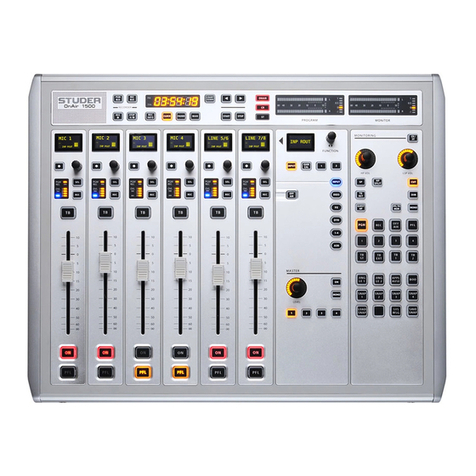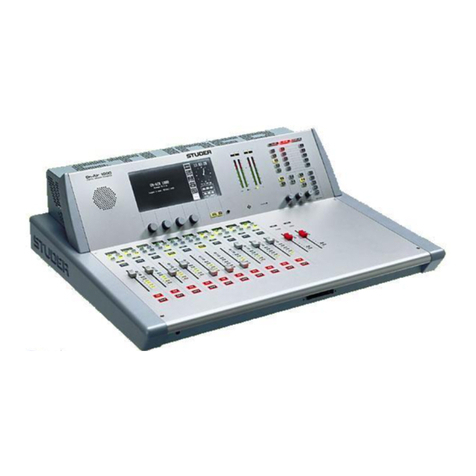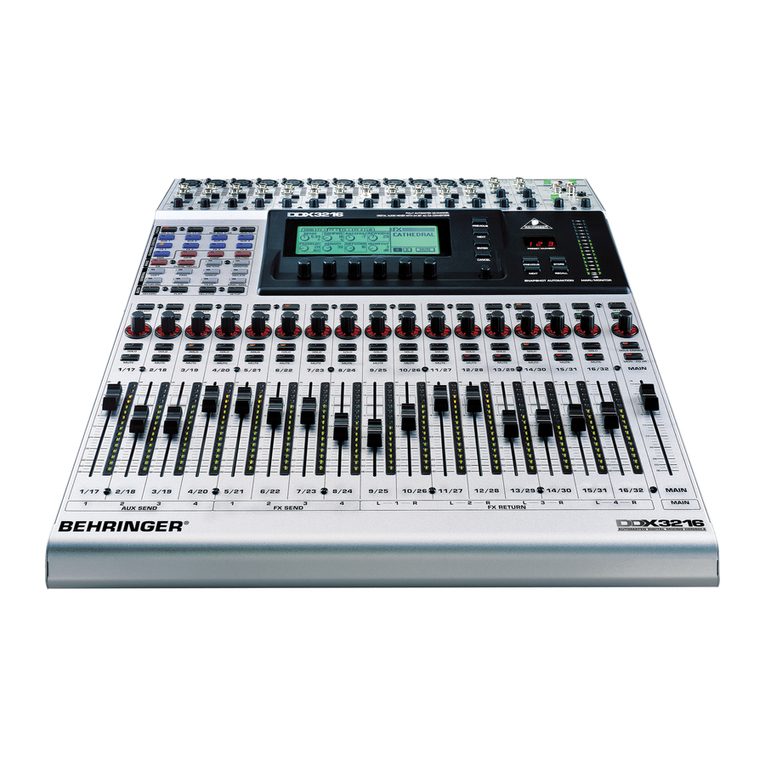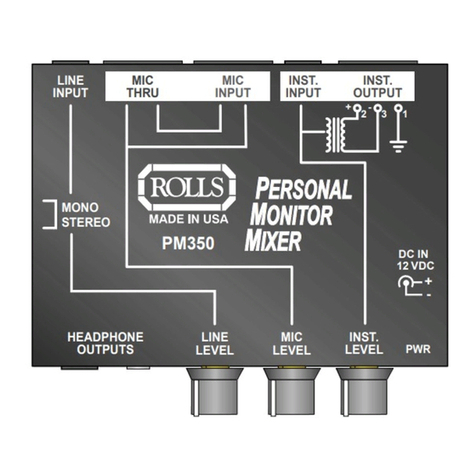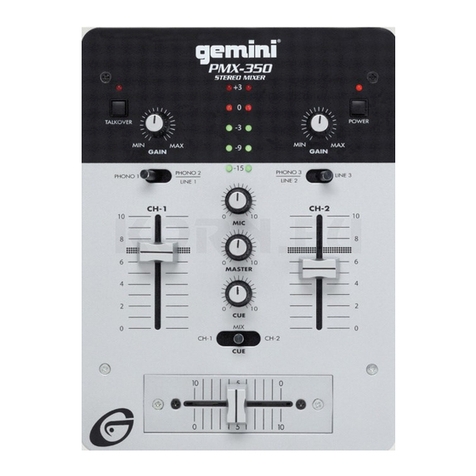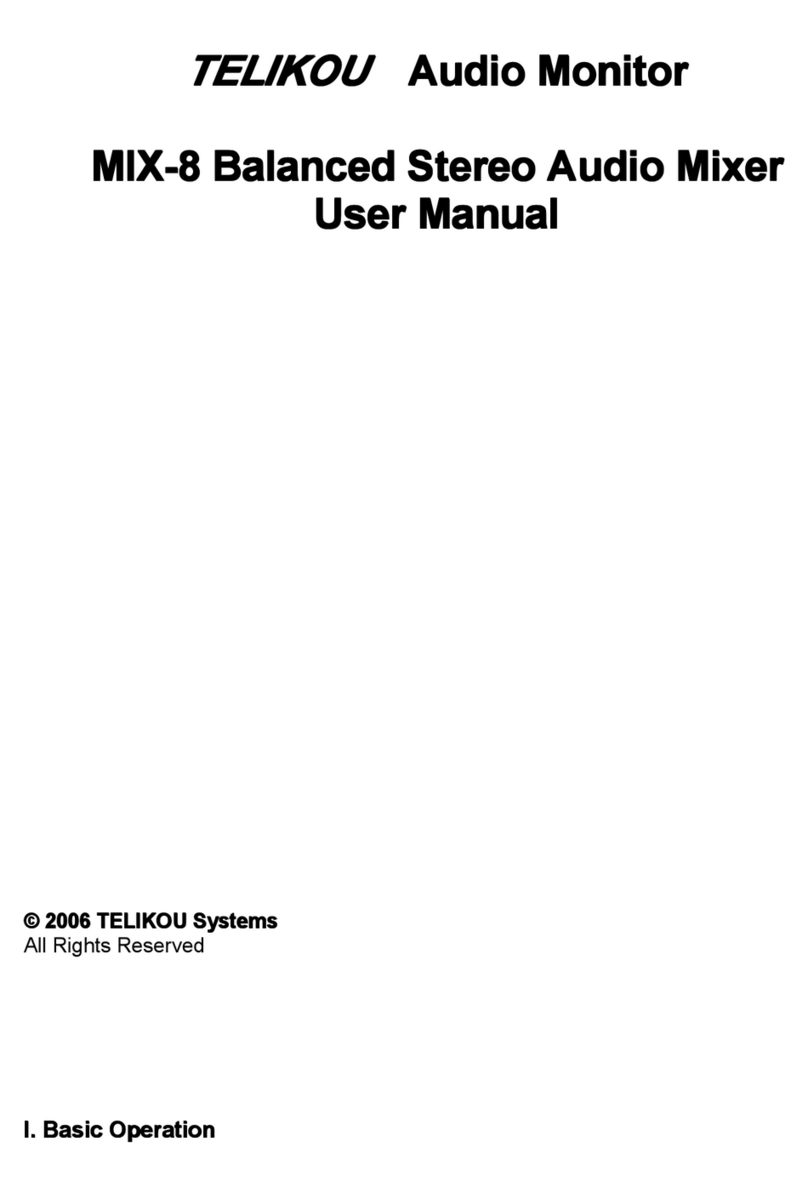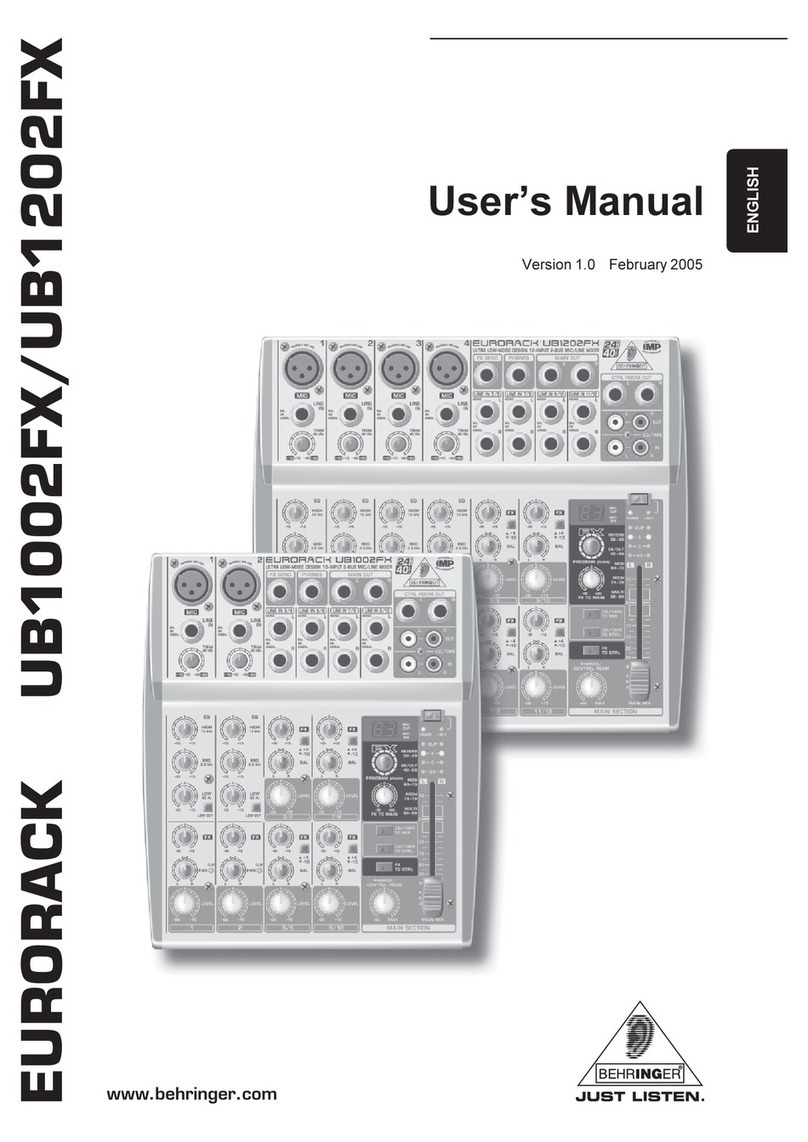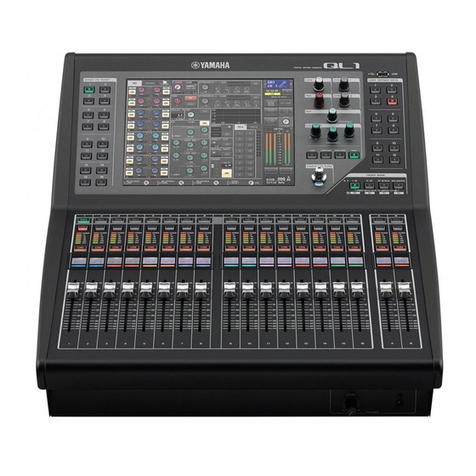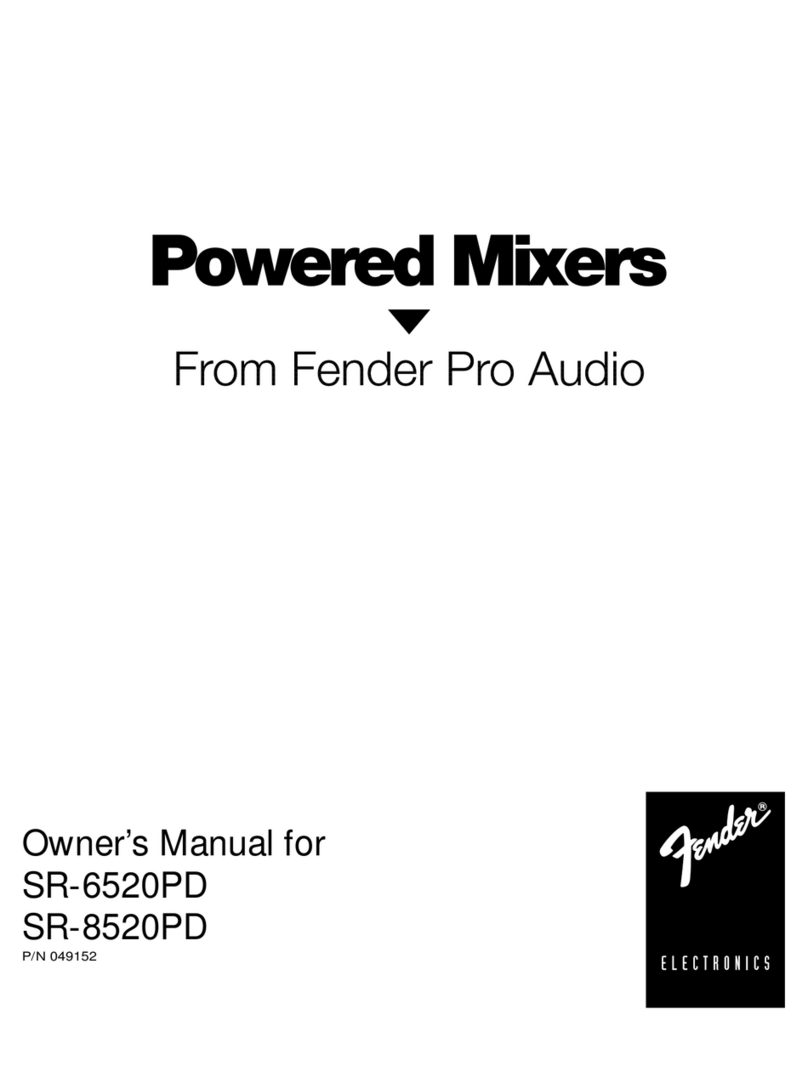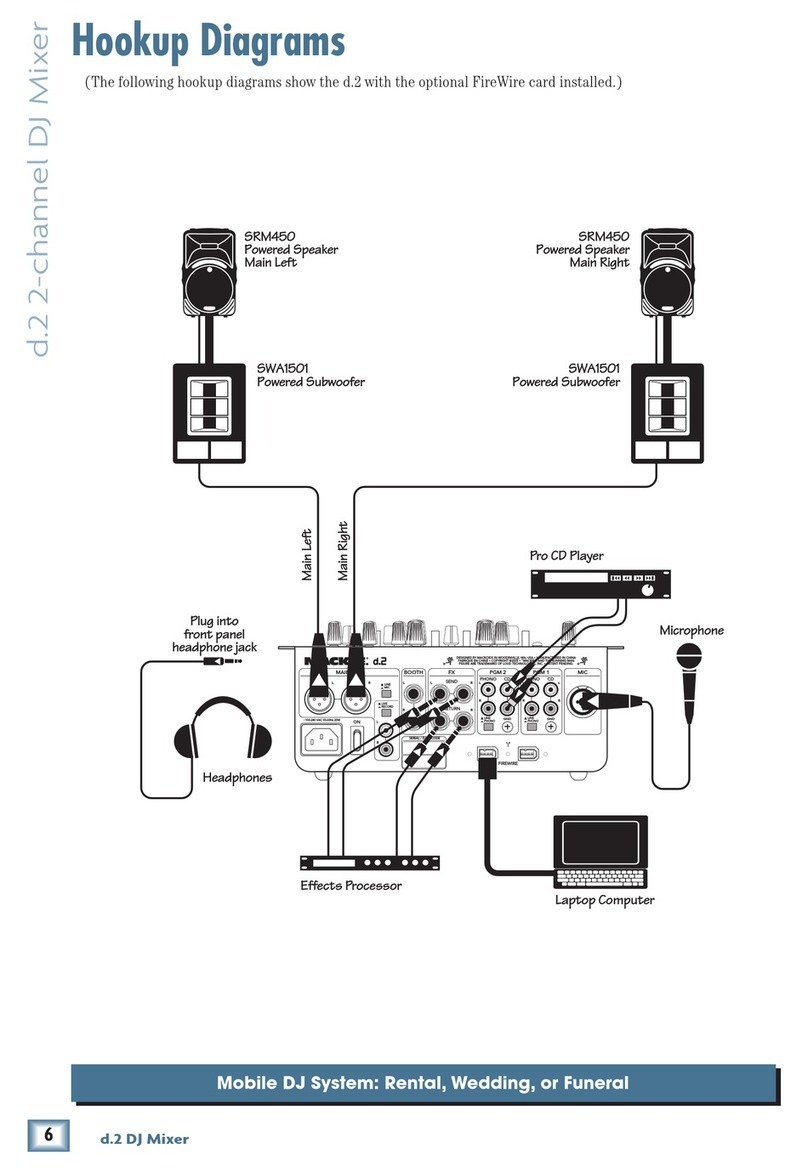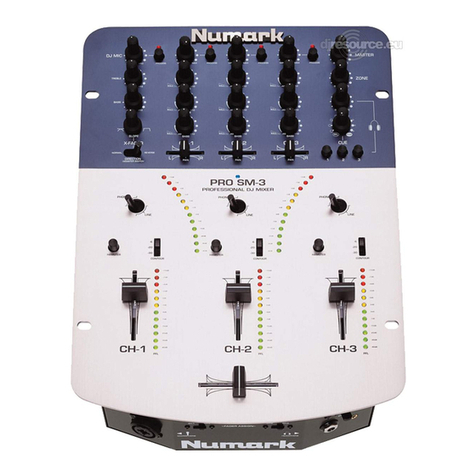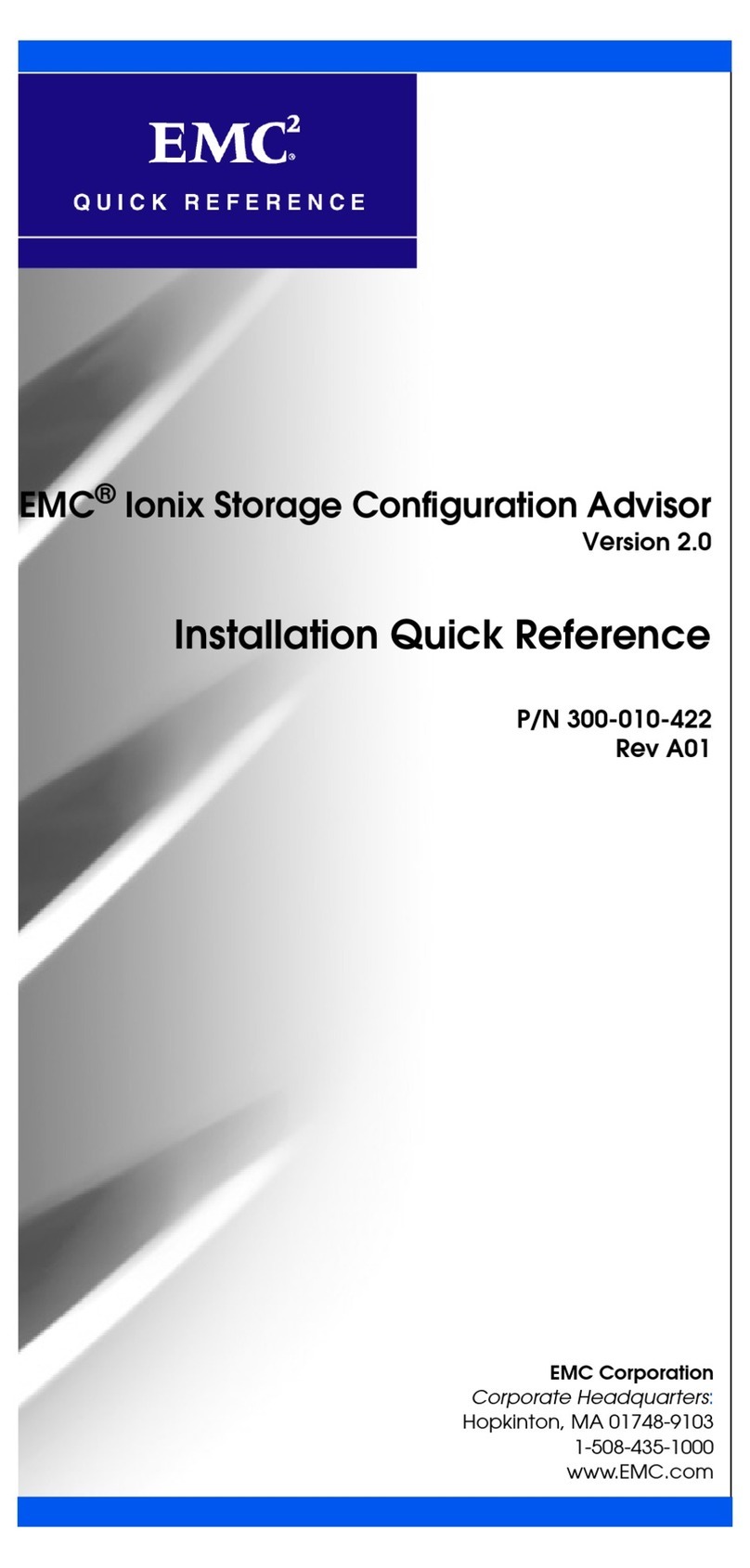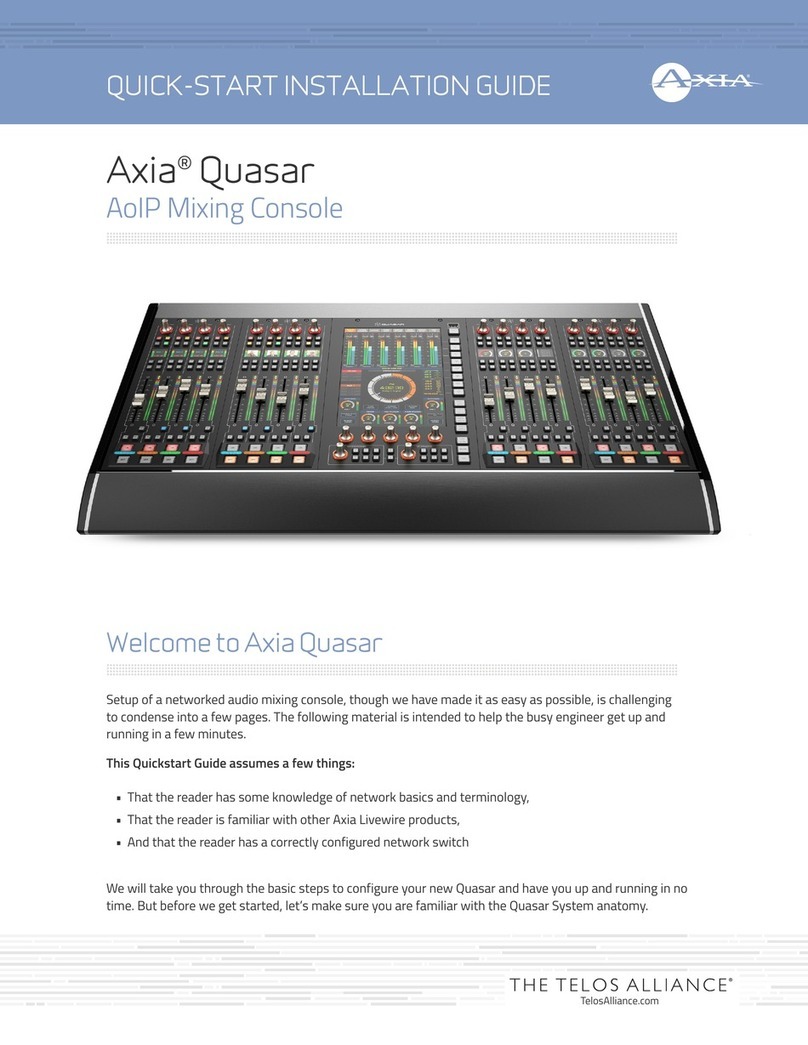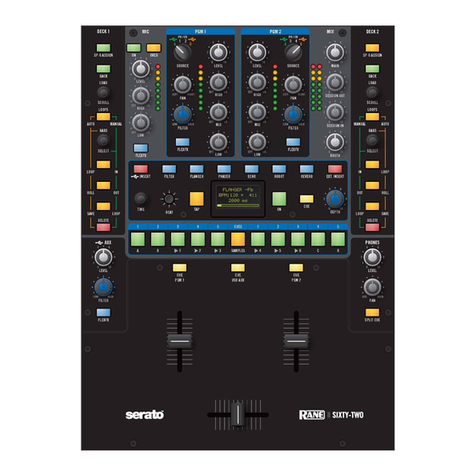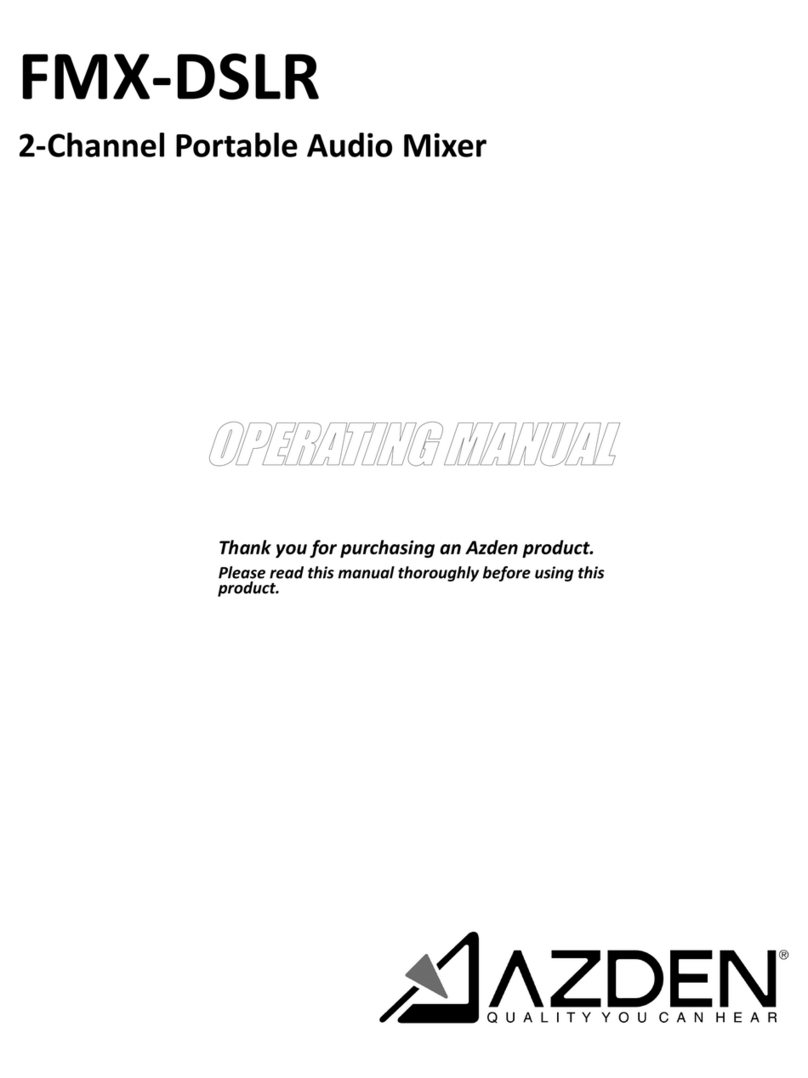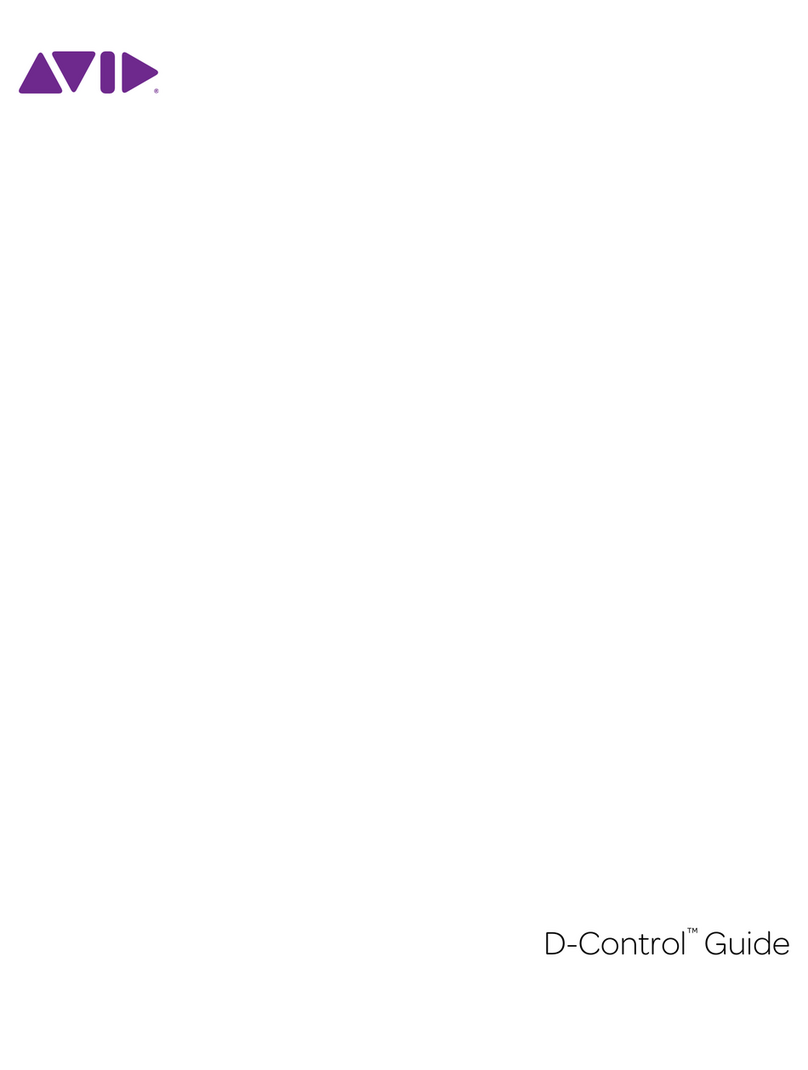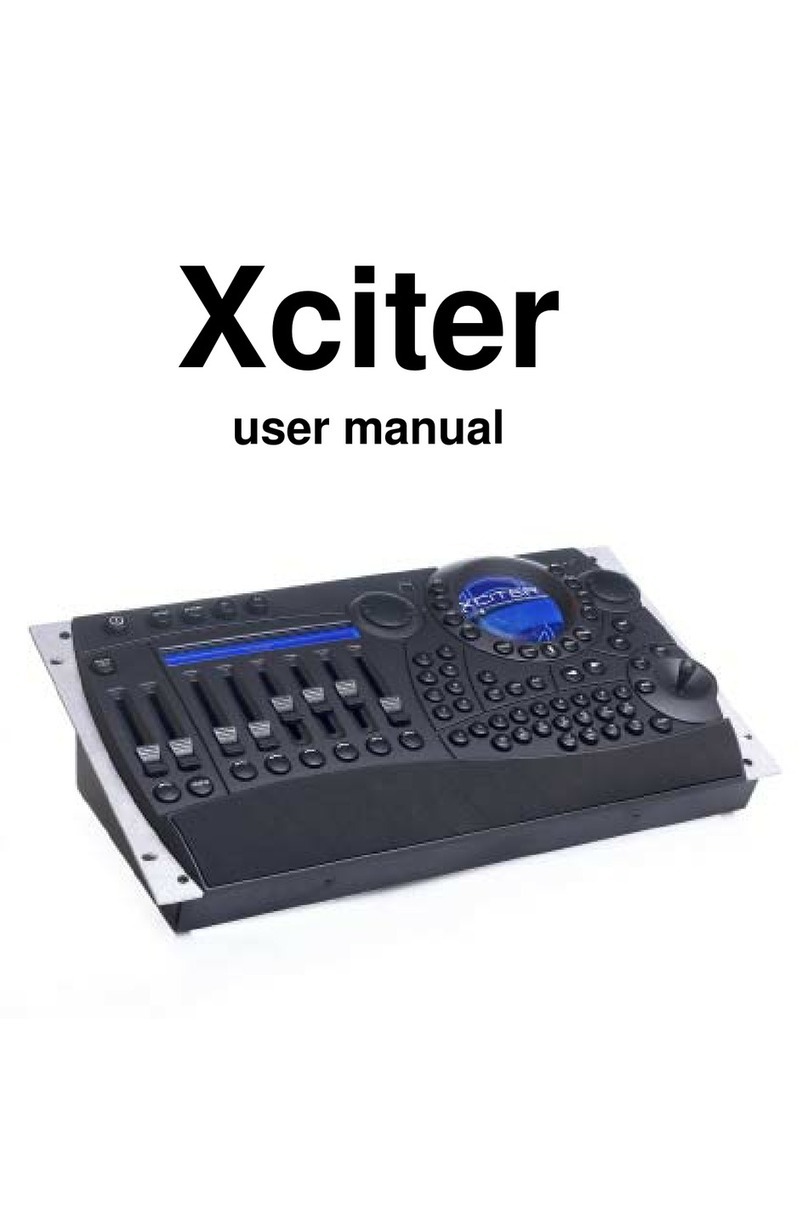Studer Compact InfinityCore 300 User manual

Studer Compact InfinityCore
(For Vista 5, Vista V and Vista X Systems)
Operating Instructions

Disclaimer
The information in this document has been carefully checked and is believed to be accurate at the time of publica-
tion. However, no responsibility is taken by us for inaccuracies, errors, or omissions, nor is any liability assumed for
any loss or damage resulting either directly or indirectly from use of the information contained withinit.
Prepared and edited by Copyright by Studer ProfessionalAudio GmbH
StuderProfessionalAudio GmbH
Technical Documentation
Riedthofstrasse 214
CH-8105 Regensdorf - Switzerland
Order no. 5057249
http://www.studer.ch Subject to change
Studer is a registered trade mark of Studer Professional Audio GmbH, Regensdorf

Safety Information
I
For Your Own Safety and to Avoid Invalidation of the Warranty
Please Read This Section Carefully
• Read these instructions.
• Keep these instructions.
• Heed all warnings.
• Follow all instructions.
• Do not use this apparatus near water.
• Clean only with a dry cloth.
• Do not block any ventilation openings. Install in accordance with the
manufacturer's instructions.
• Do not install near any heat sources such as radiators, heat registers,
stoves, or other apparatus (including amplifiers) that produce heat.
• Do not defeat the safety purpose of a polarised or grounding type plug. A
polarised plug has two blades with one wider than the other. A grounding
type plug has two blades and a third grounding prong. The wide blade or
the third prong are provided for your safety. If the provided plug does not
fit into your outlet, consult an electrician for replacement of the obsolete
outlet
• Protect the power cord from being walked on or pinched particularly
at plugs, convenience receptacles and the point where they exit from the
apparatus.
• Only use attachments/accessories specified by the manufacturer.
• Use only with the cart, stand, tripod, bracket or table specified by the
manufacturer, or sold with the apparatus. When a cart is used, use cau-
tion when moving the cart/apparatus combination to avoid injury from
tip-over.
• Refer all servicing to qualified service personnel. Servicing is required
when the apparatus has been damaged in any way, such as the power
supply cord or plug is damaged, liquid has been spilled or objects fallen
into the apparatus, the apparatus has been exposed to rain or moisture,
does not operate normally, or has been dropped.
Note: It is recommended that all maintenance and service on the product
should be carried out by Studer or its authorised agents. Studer cannot
accept any liability whatsoever for any loss or damage caused by service,
maintenance or repair by unauthorised personnel.
WARNING: To reduce the risk of fire or electric shock, do not expose this apparatus
to rain or moisture. Do not expose the apparatus to dripping or splashing
and do not place objects filled with liquids, such as vases, on the appara-
tus.
• No naked flame sources, such as lighted candles, should be placed on the
apparatus.
• Ventilation should not be impeded by covering the ventilation openings
with items such as newspapers, table cloths, curtains etc.
WARNING: Do not use this apparatus in very dusty atmospheres, or in atmospheres
containing flammable gases or chemicals.
• THIS APPARATUS MUST BE EARTHED. Under no circumstances
should the safety earth be disconnected from the mains lead.
• The mains supply disconnect device is the mains plug. It must remain
accessible so as to be readily operable when the apparatus is in use.
• If any part of the mains cord set is damaged, the complete cord set should
be replaced. The following information is for reference only. The wires
in the mains lead are coloured in accordance with the following code:

Safety Information
Ensure that these colour codes are followed carefully in the event of the
plug being changed
Lithium Battery !
!
Working Safely With Sound
Permissible Noise Exposure:Duration per day [h] Sound level [dBA, slow response]
8 90
6 92
4 95
3 97
2 100
!1.5 102
1 105
0.5 110
<0.25 115
II
• Protective Earth (Ground): Green/Yellow (US: Green or Green/
Yellow)
• Neutral: Blue (US: White)
• Live (Hot): Brown (US: Black)
As the colours of the wires in the mains lead may not correspond with
the coloured markings identifying the terminals in your plug, proceed
as follows:
• The wire which is coloured Green and Yellow must be connected to
the terminal in the plug which is marked with the letter E or by the
earth symbol.
• The wire which is coloured Blue must be connected to the terminal in
the plug which is marked with the letter N.
• The wire which is coloured Brown must be connected to the terminal
in the plug which is marked with the letter L.
• This unit is capable of operating over a range of mains voltages, as
marked on the rear panel.
Installed lithium batteries must be replaced by the same or an equivalent
type. Danger of explosion if batteries are incorrectly replaced or when
terminals are shorted.
Installed lithium batteries must not be exposed to excessive heat such as
direct sunshine, fire or the like.
Note: This equipment has been tested and found to comply with the limits for a
Class A digital device, pursuant to Part 15 of the FCC Rules. These limits are
designed to provide reasonable protection against harmful interference when
the equipment is operated in a commercial environment. This equipment gen-
erates, uses and can radiate radio frequency energy and, if not installed and
used in accordance with the instruction manual, may cause harmful interfer-
ence to radio communications. Operation of this equipment in a residential
area is likely to cause harmful interference in which case the user will be
required to correct the interference at his own expense.
This Class A digital apparatus meets the requirements of the Canadian
Interference-Causing Equipment Regulations.
Cet appareil numérique de la Classe A respecte toutes les exigences du Règle-
ment sur le matériel brouilleur du Canada.
Although your new console will not make any noise until you feed it signals,
it has the capability to produce sounds that, when monitored through a moni-
tor system or headphones, can damage hearing over time.The table below is
taken from the Occupational Safety & Health Administration directive on
occupational noise exposure (1926.52):

Safety Information
III
Conformingto this directive will minimise the risk of hearingdamage caused
bylong listeningperiods.Asimplerule to followis:The longer you listen, the
lowertheaveragevolumeshouldbe.Pleasetakecarewhenworkingwithyour
audio system – if you are manipulating controls which you don’t understand
(which we all do when we are learning), make sure your monitoring levelis
turned down. Remember that your ears are the most important tool of your
trade. Look after them, and they will look after you. Most importantly: Don’t
be afraid to experiment to find out how each parameter affects the sound;
this will extend your creativity and help you to get the bestresults.
A1 Safety Symbol Guide
For your own safety and toavoid invalidation of the warranty, all text marked
with these symbols should be readcarefully.
Toreducetheriskofelectricshock,donotremove covers.Nouser-serviceable
parts inside. Refer servicing to qualified service personnel (i.e., persons
having appropriate technical training and experience necessary to be aware
of hazards to which they are exposed in performing a repair action, and of
measures to minimize the danger of themselves).
The lightning flash with arrowhead symbol is intended to alert the user to the
presence of un-insulated “dangerous voltage” within the product’s enclosure
that may be of sufficient magnitude to constitute a risk of electric shock to
persons.
The exclamation point within an equilateral triangle is intended to alert the
user to the presence of important operating and maintenance (servicing)
instructions in the literature accompanying the appliance.
Headphones safety warnings contain important information and useful tips
on headphone outputs and monitoring levels.
Assemblies or sub-assemblies of this product can contain opto-electronic
devices. As long as these devices comply with Class I of laser or LED prod-
ucts according to EN 60825-1:1994, they will not be expressly marked on
the product. If a special design should be covered by a higher class of this
standard, the device concerned will be marked directly on the assembly or
sub-assembly in accordance with the abovestandard.
A2 First Aid
In Case of Electric Shock: Separate the person as quickly as possible from the electric powersource:
• By switching the equipment off,
• By unplugging or disconnecting the mains cable, or
•By pushing the person away from the power source, using dry insulating
material (such as wood or plastic).
•After having suffered an electric shock, always consult adoctor.
Warning! Do not touch the person or his clothing before the power is turned off,
otherwise you stand the risk of suffering an electric shock aswell!
If the Person is Unconscious: • Lay the person down
• Turn him to oneside
•Check the pulse
• Reanimate the person if respiration ispoor
•Call for a doctorimmediately.
!
!
CAUTION
RISK OF ELECTRIC SHOCK
DO NOT OPEN
ATTENTION
RISQUE DE CHOC ELECTRIQUE
NE PAS OUVRIR
ACHTUNG
GEFAHR: ELEKTRISCHER SCHLAG
NICHT ÖFFNEN

IV
Installation / EMC
BGeneral Installation Instructions
Please consider besides these general instructions also any product-specific
instructions in the “Installation” chapter of this manual.
B1 Unpacking
Check the equipment for any transport damage. If the unit is mechanically
damaged, if liquids have been spilled or if objects have fallen into the unit,
it must not be connected to the AC power outlet, or it must be immediately
disconnected by unplugging the power cable. Repair must only be performed
by trained personnel in accordance with the applicable regulations.
B2 Installation Site
Install the unit in a place where the following conditions are met:
•The temperature and the relative humidity of the environment must be
within the specified limits during operation of the unit. Relevant values
are the ones at the air inlets of the unit (refer to Appendix1).
•Condensation must be avoided. If the unit is installed in a location with
large variation of ambient temperature (e.g. in an OB-van), appropriate
precautions must be taken before and after operation (refer to Appendix
1).
•Unobstructed air flow is essential for proper operation. Air vents of the
unit are a functional part of the design and must not be blocked in any
way during operation (e.g. by objects placed upon them, placement of the
unit on a soft surface, or installation of the unit within a rack or piece of
furniture).
•The unit must not be heated up by external sources of heat radiation (sun-
light, spotlights).
B3 Earthing and Power Supply
Earthing of units with mains supply (class I equipment) is performed via
the protective earth (PE) conductor integrated in the mains cable. Units with
battery operation (< 60 V, class III equipment) must be earthed separately.
Earthingthe unit isoneof the measuresforprotectionagainstelectricalshock
hazard(dangerousbodycurrents).Hazardousvoltagemaynotonlybecaused
by a defective power supply insulation, but may also be introduced by the
connected audio or control cables.
If the unit is installed with one or several external connections, its earthing
must be provided during operation as well as while the unit is not operated.
If the earthing connection can be interrupted, for example, by unplugging
the mains plug of an external power supply unit, an additional, permanent
earthing connection must be installed using the provided earth terminal.
Avoid ground loops (hum loops) by keeping the loop surface as small as
possible (by consequently guiding the earth conductors in a narrow, parallel
way), and reduce the noise current flowing through the loop by inserting an
additional impedance (common-mode choke).

V
Installation
Class I Equipment (Mains Operation)
Should the equipment be delivered without a matching mains cable, the latter
has to be prepared by a trained person using the attached female plug (IEC
320 / C13 or IEC 320 / C19) with respect to the applicable regulations in
your country.
Before connecting the equipment to theAC power outlet, check that the local
line voltage matches the equipment rating (voltage, frequency) within the
admissible tolerance. The equipment fuses must be rated in accordance with
the specifications on the equipment.
Equipment supplied with a 3-pole appliance inlet (protection conforming to
class I equipment) must be connected to a 3-pole AC power outlet in such a
way that the equipment cabinet is connected to the protective earth.
For information on mains cable strain relief, please refer to Appendix 2.
Female Plugs (IEC320), Front-Side View:
L N L N
PE PE
IEC 320 / C13 IEC 320 /C19
European Standard
(CENELEC)
North American Standard
(NAS)
Brown
L (Live)
Black
Blue
N (Neutral)
White
Green/Yellow
PE (Protective Earth)
Green (or Green/Yellow)
Class III Equipment (Battery Operation up to 60 VDC)
Equipment of this protection class must be earthed using the provided earth
terminal if one or more external signals are connected to the unit (see expla-
nation at the beginning of this paragraph).
B4 Electromagnetic Compatibility (EMC)
The unit conforms to the protection requirements relevant to electromagnetic
phenomena that are listed in guidelines 89/336/EC and FCC, part 15.
•The electromagnetic interference generated by the unit is limited in such
a way that other equipment and systems can be operatednormally.
•The unit is adequately protected against electromagnetic interference so
that it can operate properly.
The unit has been tested and conforms to the EMC standards of the speci-
fied electromagnetic environment, as listed in the following declaration. The
limits of these standards ensure protection of the environment and cor-
responding noise immunity of the equipment with appropriate probability.
However, a professional installation and integration within the system are
imperative prerequisites for operation without EMC problems.
For this purpose, the following measures must be followed:
•Install the equipment in accordance with the operating instructions. Use
the supplied accessories.
•In the systemand in the vicinity where the equipment is installed,use only
components (systems, equipment) that also fulfill the EMC standards for
the given environment.

VI
ESD / Repair
•Use a system grounding concept that satisfies the safety requirements
(class I equipment must be connected with a protective ground conduc-
tor) and that also takes into consideration the EMC requirements. When
deciding between radial, surface, or combined grounding, the advantages
and disadvantages should be carefully evaluated in each case.
•Use shielded cables where shielding is specified. The connection of the
shield to the corresponding connector terminal or housing should have a
large surface and be corrosion-proof. Please note that a cable shield con-
nected only single-ended can act as a transmitting or receiving antenna
within the corresponding frequencyrange.
•Avoid ground loops or reduce their adverse effects by keeping the loop
surface as small as possible, and reduce the noise current flowing through
theloopbyinsertinganadditionalimpedance(e.g.common-modechoke).
•Reduce electrostaticdischarge (ESD) of persons by installingan appropri-
atefloorcovering(e.g.acarpetwithpermanentelectrostaticfilaments)and
by keeping the relative humidity above 30%. Further measures (e.g.con-
ducting floor) are usually unnecessary and only effective if usedtogether
with corresponding personal equipment.
•When using equipment withtouch-sensitive operator controls, please take
carethat the surroundingbuildingstructureallows for sufficientcapacitive
coupling of the operator. This coupling can be improved by an additional,
conducting surface in the operator’s area, connected to the equipment
housing(e.g. metalfoil underneath thefloor covering, carpetwithconduc-
tive backing).
CMaintenance
All air vents and openings for operating elements (faders, rotary knobs) must
be checked on a regular basis, and cleaned in case of dust accumulation. For
cleaning, a soft paint-brush or a vacuum cleaner isrecommended.
Cleaning the surfaces of the unit is performed with a soft, dry cloth or a soft
brush.
Persistent contaminationcan betreatedwitha cloththatis slightlyhumidified
with a mild cleaning solution, such as dishwashingdetergent.
For cleaning display windows, commercially available computer/TVscreen
cleaners are suited. Use only a slightly damp (never wet)cloth.
Never use any solvents for cleaning the exterior of the unit! Liquids must
never be sprayed or poured on directly!
For equipment-specific maintenance information please refer to the corre-
sponding chapter in the operating and service manuals.
DElectrostatic Discharge during Maintenance and Repair
Caution: Observe the precautions for handling devices sensitive to electrostatic
discharge!
Many semiconductor components are sensitive to electrostatic discharge
(ESD). The lifespan of assemblies containing such components can be dras-
tically reduced by improper handling during maintenance and repair. Please
observe the following rules when handling ESD sensitivecomponents:
•ESD sensitive components should only be stored and transported in the
packing material specifically provided for thispurpose.

VII
EMC / Maintenance / ESD
•When performing a repair by replacing complete assemblies, the removed
assembly must be sent back to the supplier in the same packing material
in which the replacement assembly was shipped. If this should not be the
case, any claim for a possible refund will be null andvoid.
•Unpacked ESD sensitive components should only be handled in ESD
protected areas (EPA, e.g. area for field service, repair or service bench)
and only be touched by persons wearing a wristlet connected to the
ground potential of the repair or service bench by a series resistor. The
equipment to be repaired or serviced as well as all tools and electrically
semi-conducting work, storage, and floor mats should also be connected
to this ground potential.
• TheterminalsofESDsensitivecomponentsmustnotcome inuncontrolled
contact with electrostatically chargeable or metallic surfaces (voltage
puncture, discharge shock hazard).
•To prevent the components from undefined transient stress and possible
damage due to inadmissible voltages or compensation currents,electrical
connections should only be established or separated when the equipment
is switched off and after any capacitor charges havedecayed.
ERepair
By removing housing parts or shields, energized parts may be exposed. For
this reason the following precautions must be observed:
•Maintenance may only be performed by trained personnel in accordance
with the applicable regulations.
•The equipment must be switched off and disconnected from theAC power
outlet before any housing parts are removed.
•Even if the equipment is disconnected from the power outlet, parts with
hazardouscharges(e.g. capacitors,picturetubes)mustnotbetoucheduntil
they have been properly discharged. Do not touch hot components (power
semiconductors, heat sinks, etc.) before they have cooledoff.
•If maintenance is performed on a unit that is opened while being switched
on, no un-insulated circuit components and metallic semiconductor hous-
ings must be touched, neither with bare hands nor with un-insulated tools.
Certain components pose additional hazards:
•Explosion hazard fromlithium batteries,electrolyticcapacitors andpower
semiconductors (Observe the component’s polarity. Do not short battery
terminals. Replace batteries only by the same type).
•Implosion hazard from evacuated displayunits.
•Radiation hazard from laser units (non-ionizing), picture tubes (ionizing).
•Caustic effect of display units (LCD) and components containing liquid
electrolyte.
Such components should only be handled by trainedpersonnel who are prop-
erly protected (e.g. protection glasses, gloves).

Repair / Disposal
VIII
E1 SMD Components
Studer has no commercially available SMD components in stock for service
purposes. For repair, the corresponding devices have to be purchased locally.
The specifications of special components canbe found in the service manual.
SMD components should only be replaced by skilled specialists using appro-
priate tools. No warranty claims will be accepted for circuit boards that have
been damaged. Proper and improper SMD soldering joints are illustrated
below.
Copper
Track
SMD
Component
Adhesive
Solder
PCB
Soldering Iron
Dismounting
Desoldering
Iron
Soldering
Iron
Desolder
Wick Desolder
Wick
Heat and Remove
Cleaning
FDisposal
Mounting
Examples
Solder
Ø 0.5...0.8 mm
Heating Time < 3 s per Side
1
Packing Materials The packing materials have been selected with environmental and disposal
issues in mind. All packing material can be recycled. Recycling packing saves
raw materials and reduces the volume of waste.
If you need to dispose of the transport packing materials, please try to use
recyclable means.
Used Equipment Used equipment contains valuable raw materials as well as materials that
must be disposed of professionally. Please return your used equipment via an
authorized specialist dealer or via the public waste disposal system, ensuring
any material that can be recycled is.
Please take care that your used equipment cannot be abused. To avoid abuse,
delete sensitive data from any data storage media. After having disconnected
your used equipment from the mains supply, make sure that the mains con-
nector and the mains cable are made useless.

Conformity
IX
GDeclarations of Conformity
G1 Class A Equipment - FCC Notice
G2 CE Declaration of Conformity
We,
Studer Professional Audio GmbH,
CH-8105 Regensdorf,
declare under our sole responsibility that the product
Studer Compact Infinity Core
to which this declaration relates, according to following regulations of EU
directives and amendments
•Low Voltage Directive (LVD): 2014/35/EU
•Electromagnetic Compatibility (EMC): 2014/30/EU
• Restriction of Hazardous Substances (RoHS 2):2011/65/EU
is in conformity with the following standards or normative documents:
• EN 60065:2014
• EN 55032:2015
Regensdorf, May 28, 2018
This equipment has been tested and found to comply with the limits for a
Class A digital device, pursuant to Part 15 of the FCC Rules. These limits
are designed to provide a reasonable protection against harmful interfer-
ence when the equipment is operated in a commercial environment. This
equipment generates, uses, and can radiate radio frequency energy and, if
not installed and used in accordance with the instruction manual, may cause
harmful interference to radio communications. Operation of this equipment
in a residential area is likely to cause harmful interference, in which case the
user will be required to correct the interference at his own expense.
Caution: Any changes or modifications not expressly approved by the manufacturer
could void the user’s authority to operate the equipment. Also refer to relevant
information in this manual.

X
Appendix
Appendix 1: Air Temperature and Humidity
General
Normal operation of the unit or systemis warranted under the ambient condi-
tions defined by EN 60721-3-3, set IE32, value 3K3.
This standard consists of an extensive catalogue of parameters, the most
important of which are: ambient temperature +5...+40 °C, relative humidity
5...85%(i.e.,noformationofcondensationorice); absolutehumidity1...25 g/
m³; rate of temperature change < 0.5 °C/min. These parameters are dealt with
in the following paragraphs.
Under these conditions the unit or system starts and works without any prob-
lem. Beyond these specifications, possible problems are described below.
Ambient Temperature
Units and systems by Studer are generally designed for an ambient tempera-
ture range (i.e. temperature of the incoming air) of +5 °C to +40 °C. When
rack mounting the units, the intended air flow and herewith adequate cooling
must be provided. The following facts must be considered:
•The admissible ambient temperature range for operation of the semicon-
ductor components is 0 °C to +70 °C (commercial temperature range for
operation).
•The air flow through the installation must provide that the outgoing airis
always cooler than 70 °C.
•Average heat increase of the cooling air shall be about 20 K, allowing for
an additional maximum 10 K increase at the hot components.
•In order to dissipate 1 kW with this admissible average heat increase, an
air flow of 2.65 m³/min is required.
Example: ArackdissipatingP = 800 Wrequiresanair flow of 0.8 * 2.65 m³/min which
corresponds to 2.12 m³/min.
•If the cooling function of the installation must be monitored (e.g. for fan
failure or illuminationwithspot lamps), the outgoing air temperature must
be measured directly above the modules at several places within the rack.
The trigger temperature of the sensors should be 65 °C to 70°C.
Frost and Dew
The unsealed system parts (connector areas and semiconductor pins) allow
for a minute formation of ice or frost. However, formation of dew visible to
the naked eye will already lead to malfunctions. In practice, reliable opera-
tion can be expected in a temperature range above –15 °C, if the following
general rule is considered for putting the cold system into operation:
If the air within the system is cooled down, the relative humidity rises. If it
reaches100%, condensation will arise,usuallyintheboundarylayer between
the air and a cooler surface, together with formation of ice or dew at sensi-
tive areas of the system (contacts, IC pins, etc.). Once internalcondensation
occurs,trouble-free operationcannot be guaranteed,independentof tempera-
ture.
Before putting into operation, the system must be checked for internal for-
mation of condensation or ice. Only with a minute formation of ice, direct

Appendix
XI
evaporation (sublimation) may be expected; otherwise the system must be
heated and dried while switched off.
A system without visible internal formation of ice or condensation should be
heated up with its own heat dissipation, as homogeneously (and subsequently
as slow) as possible; the ambient temperature should then always be lower
than the one of the outgoing air.
If it is absolutely necessary to operate the cold system immediately within
warm ambient air, this air must be dehydrated. In such a case, the absolute
humidity must be so low that the relative humidity, related to the coldest
system surface, always remains below 100%.
Ensure that the enclosed air is as dry as possible when powering off (i.e. before
switching off in winter, aerate the room with cold, dry air, and remove humid
objects such as clothes from the room).
These relationships are visible from the following climatogram. For a con-
trolled procedure, thermometer and hygrometer as well as a thermometer
within the system will be required.
Example 1: An OB-van having an internal temperature of +20 °C and a relative humidity
of 40% is switched off in the evening. If the temperature falls below +5 °C,
the relative humidity will rise to 100% (7 g/m³); dew or ice will be forming.
Example 2: An OB-van is heated up in the morning with air of +20 °C and a relative
humidity of 40%. On all parts being cooler than +5 °C, dew or ice will be
forming.

Appendix
XII
Appendix 2: Mains Connector Strain Relief
Foranchoringconnectorswithoutamechanicallock (e.g. IEC mains connec-
tors), we recommend the followingarrangement:
Procedure: Thecableclampshippedwithyourunitisauto-adhesive.Formountingplease
follow the rules below:
•The surface to be adhered to must be clean, dry, and free from grease, oil,
or other contaminants. Recommended application temperature range is
+20 °C to +40 °C.
•Remove the plastic protective backing from the rear side of the clamp and
applyit firmlytothe surfaceatthe desiredposition.Allow as much timeas
possiblefor curing.Thebondcontinues todevelop for aslongas24 hours.
•For improved stability, the clamp should be fixed with a screw. For this
purpose, a self-tapping screw and an M4 bolt and nut areincluded.
•Placethe cableintothe clamp asshownintheillustration aboveand firmly
press down the internal top cover until the cable is fixed.

Appendix
Compact Infinity Core XIII
Appendix 3: Software License
Use of the software is subject to the Studer Professional Audio Software
License Agreement set forth below. Using the software indicates your accep-
tance of this license agreement. If you do not accept these license terms, you
are not authorized to use this software.
Under the condition and within the scope of the following Terms and Con-
ditions, Studer Professional Audio GmbH (hereinafter ‘Studer’) grants the
right to use programs developed by Studer as well as those of third parties
which have been installed by Studer on or within its products. References
to the license programs shall be references to the newest release of a license
program installed at the Customer’s site.
Programs Covered by the Agreement
License Programs of Studer The following Terms and Conditions grant the right to use all programs of
Studer that are part of the System and/or its options at the time of its delivery
to the Customer, as well as the installation software on the original data disk
and the accompanying documentation (‘License Material’). In thisAgreement
the word ‘Programs’ shall have the meaning of programs and data written in
machine code.
Using the software indicates your acceptance of this license agreement. If you
do not accept these license terms, you are not authorized to use this software.
Programs of Third Parties Programs of third parties are all programs which constitute part of the System
and/or its options at the time of delivery to the Customer but have not been
developed by Studer. The following conditions are applicable to programs of
third parties:
• The right to use third parties’ programs is governed by the License Agree-
ment attached hereto (if applicable), which is an integral part of this
Agreement. The Customer shall sign any and all License Agreements for
all further programs of third parties installed on the system. The Customer
shall be deemed to have received all License Agreements upon delivery
of the system and/or its options.
• Studer shall accept no responsibility or liability for, and gives no warran-
ties (express or implied) as to the programs of third parties. The Customer
waives any and all claims versus Studer for any consequential damages,
which might occur due to defects of these programs.
Right of Use
Principle Studer grants the Customer the non-exclusive right to use the License Ma-
terial in one copy on the system and/or its options as laid down by the Sales
Agreement concluded between the parties and all Terms and Conditions
which shall be deemed to form and be read and construed as part of the Sales
Agreement. This right is assignable according to the ‘Assignability’paragraph
hereinafter.
Customized Configurations The Customer is not entitled to alter or develop further the License Material
except within the expressly permitted configuration possibilities given by the
software installed on the system or elsewhere. All altered programs, includ-
ing but not limited to the products altered within the permitted configuration
possibilities, are covered by this License Agreement.

Appendix
XIV
Reverse Engineering Reverse engineering is only permitted with the express consent of Studer.
The consent of Studer can be obtained but is not limited to the case in which
the interface software can not be provided by Studer. In any case Studer has
to be informed immediately upon complete or partial reverse engineering.
Copying the License Material The Customer is entitled to make one copy of all or parts of the License
Material as is necessary for the use according to this Agreement, namely for
backup purposes. The Customer shall apply the copyright of Studer found on
the License Material onto all copies made by him. Records shall be kept by
the Customer regarding the amount of copies made and their place of keeping.
The responsibility for the original program and all copies made lies with the
Customer. Studer is entitled to check these records on first request. Copies
not needed anymore have to be destroyed immediately.
Disclosure of License Material The License Material is a business secret of Studer. The Customer shall not
hand out or in any way give access to parts of or the complete License Material
to third parties nor to publish any part of the License Material without prior
written consent of Studer. The Customer shall protect the License Material
and any copies made according to the paragraph above by appropriate defense
measures against unauthorized access. This obligation of non-disclosure is a
perpetual obligation.
Third parties are entitled to have access to the License Material if they use the
License Material at the Customer’s site in compliance with this Agreement.
Under no circumstance are third parties entitled to have access to the instal-
lation software on the original data media. The Customer shall safeguard the
original data media accordingly.
Assignability The rights granted to the Customer according to this License Agreement shall
only be assignable to a third party together with the transfer of the system
and/or its options and after the prior written consent of Studer.
Rights to License Material
With the exception of the right of use granted by this License Agreement all
proprietary rights to the License Material, especially the ownership and the
intellectual property rights (such as but not limited to patents and copyright)
remain with Studer even if alterations, customized changes or amendments
have been made to the License Material.
Studer’s proprietary rights are acknowledged by the Customer. The Customer
shall undertake no infringements and make no claims of any patent, registered
design, copyright, trade mark or trade name, or other intellectual property
right.
Warranty, Disclaimer, and Liability
For all issues not covered herewithin, refer to the ‘General Terms and Condi-
tions of Sales and Delivery’ being part of the sales contract.

Appendix
Compact Infinity Core 1
CONTENTSCONTENTS
1General..............................................................................................................................................................2
1.1 Utilization for thePurpose Intended..................................................................................................................2
1.2 First Steps..........................................................................................................................................................2
1.2.1 Unpacking and Inspection.......................................................................................................................................2
1.2.2 Installation...............................................................................................................................................................2
1.2.3 Adjustments, Repair, Cleaning................................................................................................................................4
2Introduction......................................................................................................................................................5
2.1 Key Features......................................................................................................................................................6
2.2 Hardware...........................................................................................................................................................7
2.3 Connections.......................................................................................................................................................8
2.4 System Setup..................................................................................................................................................... 9
2.5 Clocking concept of Infinity Core...................................................................................................................16
2.6 Redundancy.....................................................................................................................................................16
2.7 Service Mode...................................................................................................................................................17
2.8 Session Configuration Tool..........................................................................................................................................18
2.9 Vista Surveyor Information.............................................................................................................................20
3Modules...........................................................................................................................................................23
3.1 Core Link Card................................................................................................................................................23
3.2 Primary Power Supply.....................................................................................................................................24
3.3 D23m and D21m I/O Subsystem.....................................................................................................................24
4Dimensions......................................................................................................................................................25
4.1 Compact Core 300...........................................................................................................................................25
4.2 Compact Core 600...........................................................................................................................................25
Disclaimer
The information in this document has been carefully checked and is believed
to be accurate at the time of publication. However, no responsibility is taken
by us for inaccuracies, errors, or omissions, nor is any liability assumed for
any loss or damage resulting either directly or indirectly from use of the
information contained within it.
Document generated: 13.06.18

Compact Infinity Core
Compact Infinity Core 2
Document generated: 13.06.18
1GENERAL
1.1 Utilization for the Purpose Intended
The Studer Compact Infinity Core system is intended for professional use.
It is presumed that the unit is operated only by trained personnel. Servicing
is reserved to skilled technicians.
The electrical connections may be connected only to the voltages and signals
designated in this manual.
1.2 First Steps
1.2.1 Unpacking and Inspection
Your new system is shipped in a special packing which protects the units
against mechanical shock during transit. Care should be exercised when
unpacking so that the surfaces do not get marred.
Check the condition of the equipment for signs of shipping damage. Ifthere
shouldbeanycomplaintsyoushouldimmediatelynotifytheforwardingagent
and your nearest Studerdistributor.
Pleaseretaintheoriginal packingmaterialbecauseitoffersthebest protection
in case your equipment ever needs to be transported.
1.2.2 Installation
Primary Voltage The power supplyunitsare auto-ranging; theycan beused for mains voltages
in a range of 90 to 264 VAC, 47 to 63 Hz.
Power Connection The attached female IEC 320/C13 mains cable sockets have to be connected
to appropriate mains cables by a trained technician, respecting your local
regulations.Refertothe‘Installation, Operation, andWasteDisposal’chapter
at the beginning of this document.
Earthing This equipment must be earthed, due to the mains input filternetwork being
connected to the mains earth.
Some consideration must be given to the earthing arrangement of the system,
at the center of which is the frame. The frame is earthed to the mains earth
via the power supply.
Thermal Considerations The unit must not be used in conditions of excessive heat or cold, near any
source of moisture,in excessivelyhumid environments, or inpositions where
it is likelyto be subjectedtovibration or dust.The ambient temperature range
for normal operation of the unit is +5...+40° C.
Principal Rule The cooler the better – a temperature increase of only 10° C (18° F) reduces
component lifetime by 50%!

Compact Infinity Core
3Compact Infinity Core
Document generated: 13.06.18
Heat dissipation The following table lists the required heat dissipation which is depending on
the type of the Compact Infinity Core ( Core 300, Core 600) :
Compact Infinity Core Type
Required Heat
Dissipation
Core 300
140 W
Core 600
250 W
If the unit is mounted in a climatised rack, please note that air intake must be
at the front and air outlet at the rear of the rack.
If two Compact Infinity Cores are mounted on top of each other, there is no
space required between the two units.
Single Compact Infinity Core
Rear Front
Air
Air Compact Infinity Core
Dual Compact Infinity Core
Rear Front
Air
Compact Infinity Core
Air
Compact Infinity Core

Compact Infinity Core
Compact Infinity Core 4
Document generated: 13.06.18
1.2.3 Adjustments, Repair, Cleaning
Danger! All internal adjustments as well as repair work on this product must be per-
formed by expert technicians!
Replacing the Supply Unit The primary fuse is located within the power supply module and cannot be
changed.Incase of failure, the completepower supplyunit must bereplaced.
Please ask your nearest Studerrepresentative.
Cleaning Do not use any liquids to clean the exterior of the unit. A soft, dry cloth or
brush will usually do.
This manual suits for next models
1
Table of contents
Other Studer Music Mixer manuals
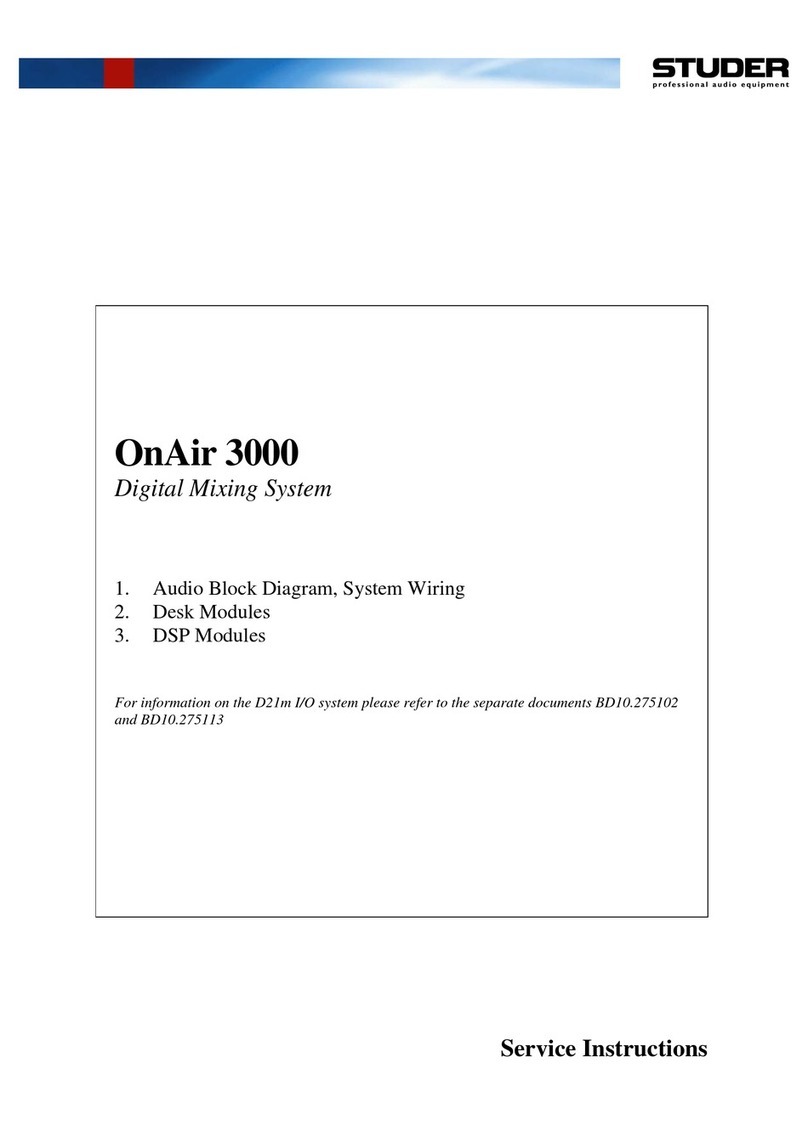
Studer
Studer OnAir 3000 Operating instructions
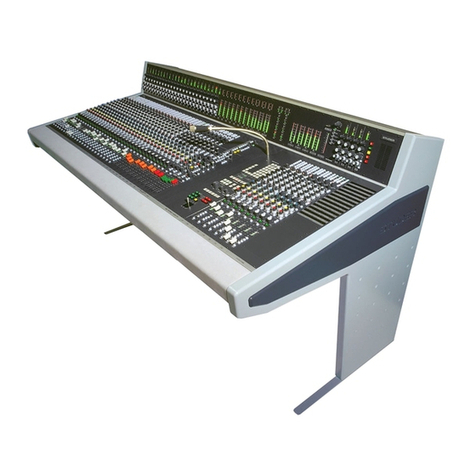
Studer
Studer 928 Operation manual
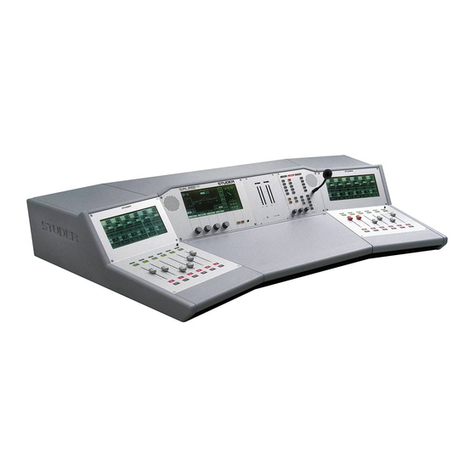
Studer
Studer OnAir 2000M2 Training manual

Studer
Studer D19m Operating instructions

Studer
Studer OnAir 2500 User manual
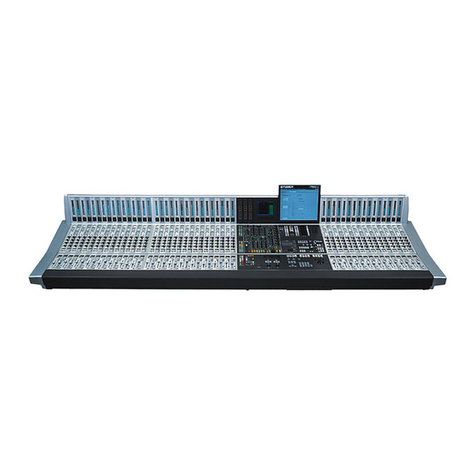
Studer
Studer D950 User manual
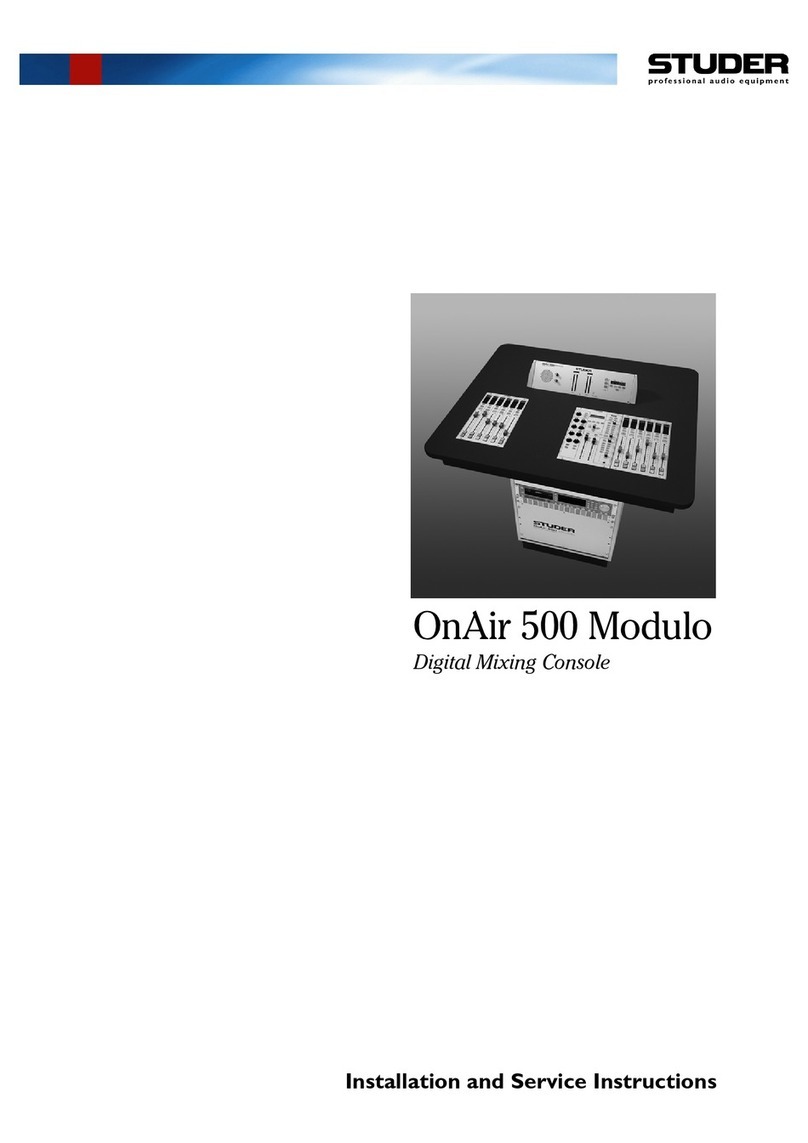
Studer
Studer OnAir 500 Modulo Quick guide
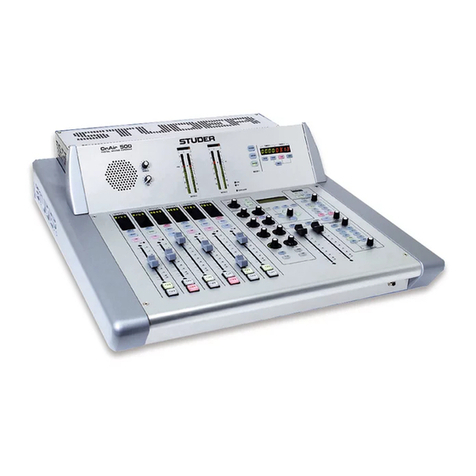
Studer
Studer OnAir 500 Modulo User manual
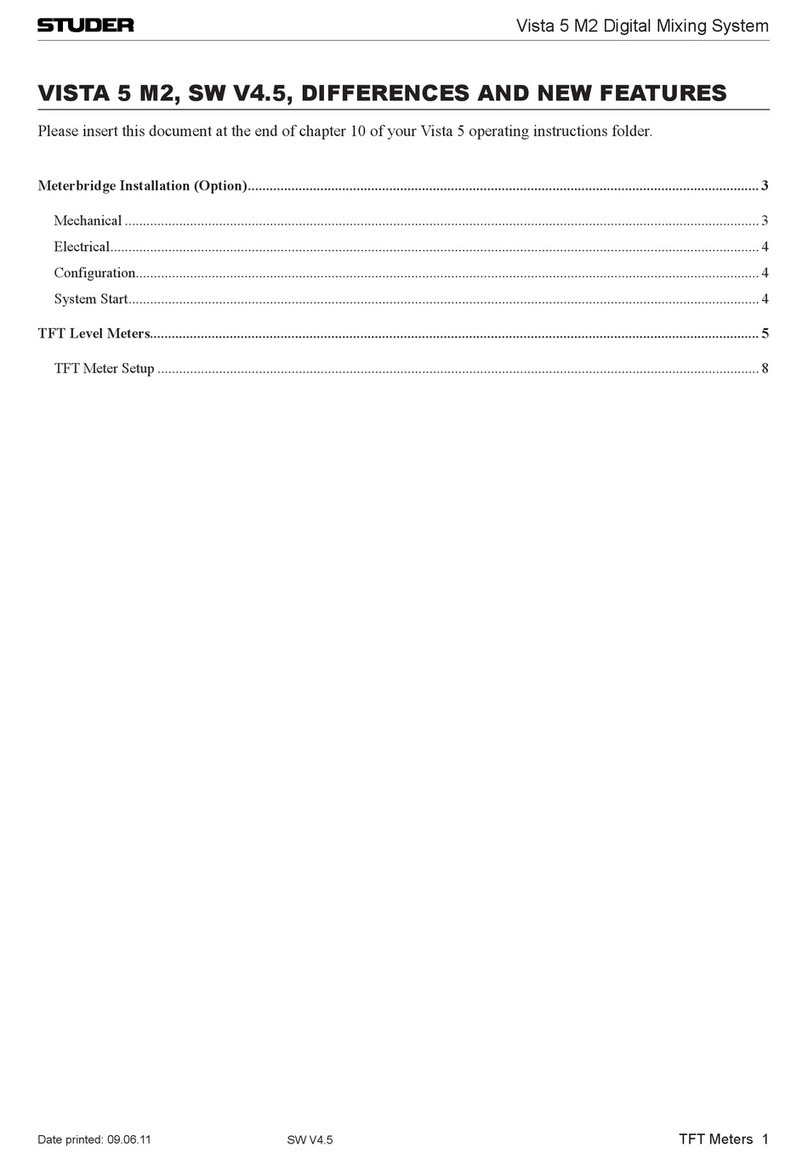
Studer
Studer Vista 5 M2 User manual
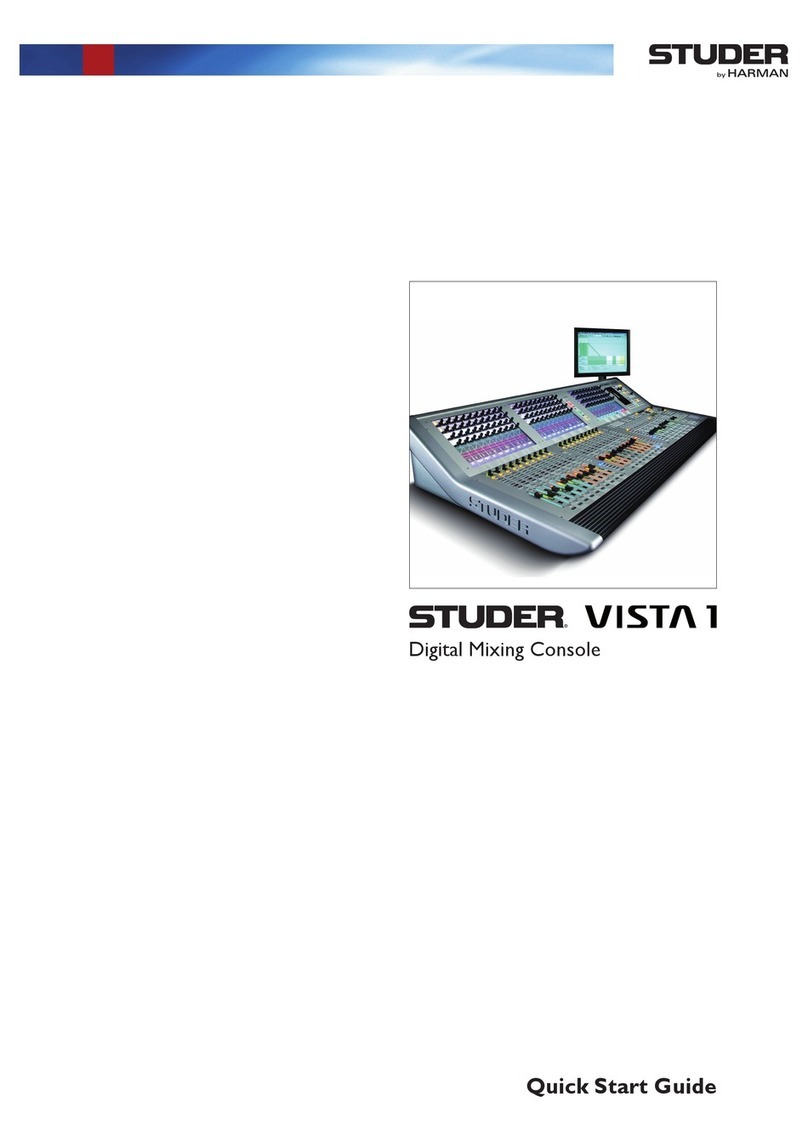
Studer
Studer Vista 1 User manual

